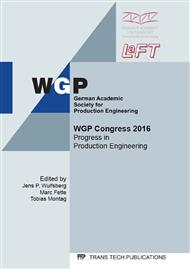p.165
p.173
p.181
p.189
p.197
p.205
p.213
p.221
p.228
Production of Deep Bore Holes with Non-Circular Profiles
Abstract:
Deep hole drilling is a process for the production of cylindrical bore holes with a large length to diameter ratio. The variation of parameters is limited to those ones of the conventional drilling process such as rotation and feed motion. A special deep hole drilling process, named “chamber-boring”, was developed for the production of contoured bore holes in axial direction [1]. For specific applications not only a contouring in axial direction is required but also a radial contouring is necessary. In the course of a ZIM – project (Central Innovation Programme for SMEs), supported by the Federal Ministry for Economic Affairs and Energy (BMWi) and in close collaboration with the BGTB GmbH and the Institute of Machining Technology (ISF), a new “chamber boring system” which allows contouring of boreholes in axial and radial directions was developed. Based on this machining system, the manufacturing of pipes with a wavelike cross section in radial direction is possible.
Info:
Periodical:
Pages:
197-204
Citation:
Online since:
August 2016
Authors:
Keywords:
Price:
Сopyright:
© 2016 Trans Tech Publications Ltd. All Rights Reserved
Share:
Citation:


